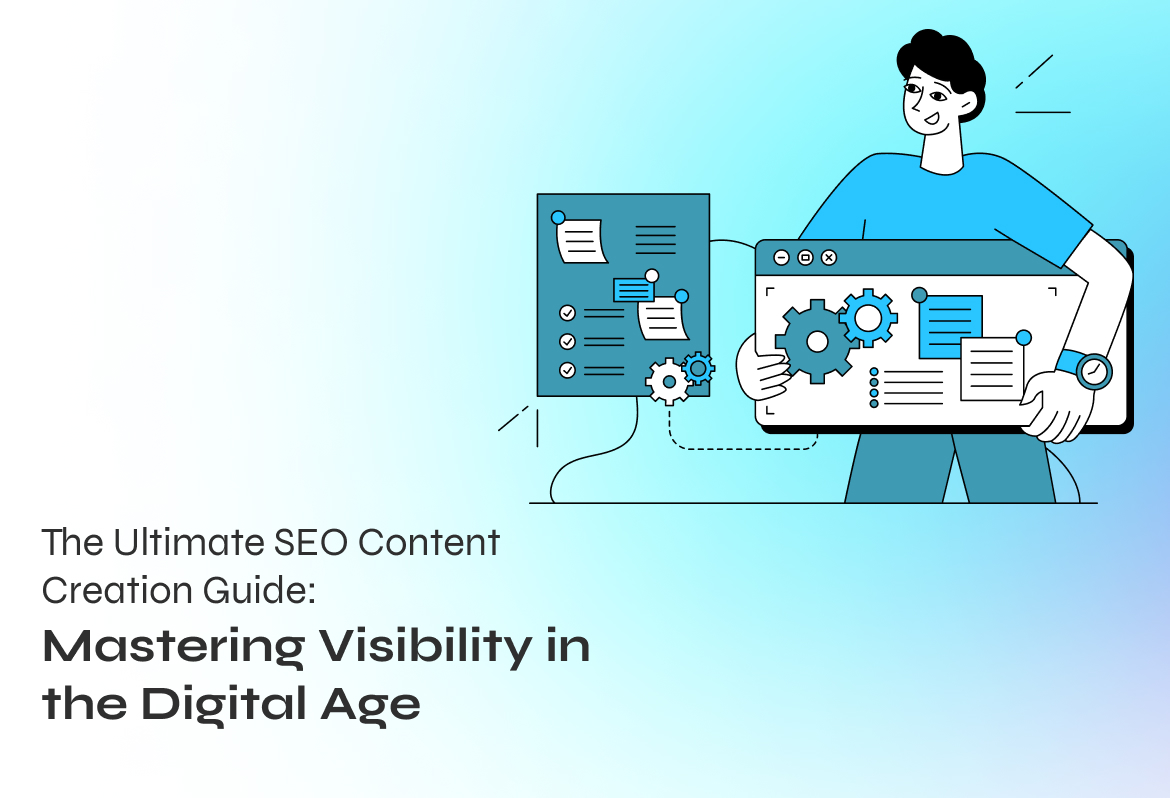If you’ve got a website and you’re not attracting traffic to it, you’re losing a lot. One of the best ways to bring traffic to your website is through SEO content.
We’re going to walk you through how to make your content stand out, step by step. We’ll start with the basic stuff and then move on to some clever tricks to make sure your content doesn’t just get found but also gets loved and shared a lot. Whether you’re just starting out with making content or you want to get even better at it, this guide has everything you need to make a big splash online.
Understanding SEO Basics
When we talk about the internet, think of SEO as the map that guides users to your content. Imagine you’re shouting in a crowded room full of people talking; SEO is what makes your voice loud enough to be heard. Now, you might wonder, what exactly SEO is? It’s Search Engine Optimization, but let’s not get tangled in jargon. In simple terms, SEO is about making your content easy to find and ranking high on search engines like Google.
Why is SEO Important?
Imagine you’ve written the most insightful article or created an amazing product page, but if it’s on the 10th page of Google search results, chances are, very few people will find it. SEO helps push your content up the ranks, making it more visible to people searching for topics you’ve covered. It’s like having a big, bright sign pointing to your content in the vast internet universe.
Key Concepts of SEO:
- Keywords: These are the words or phrases people type into search engines when they’re looking for something. If your content contains these keywords, it’s more likely to show up in search results. It’s about getting into the minds of your audience and predicting what they’ll search for.
- Search Engine Algorithms: Think of these as the rules of the game. Search engines use complex formulas to decide which pieces of content are the most relevant to a search query. These algorithms consider factors like how often a keyword appears, the quality of the content, and how many other websites link to it.
- Ranking Factors: There are over 200 factors that can affect where your content ranks on a search engine. Some of the big players include the quality of your content, mobile-friendliness, page speed, and how user-friendly your website is.
Understanding these basics is like laying the foundation for a house. It’s the starting point for creating and optimizing content that reaches your audience and engages and intrigues them. With this groundwork laid, let’s move on to the next crucial step: finding and selecting the right keywords, which we’ll cover in the “Keyword Research and Selection” section
Keyword Research and Selection
Diving into the world of SEO, if the basics of SEO are the foundation, then keywords are the bricks. They are essential in building your path to visibility on search engines. Let’s break down the process of keyword research and selection into simple, actionable steps, ensuring your content not only matches what your audience is searching for but also stands out in the sea of online information.
Why Keyword Research Matters
Imagine you’re opening a coffee shop. You wouldn’t just guess what kinds of coffee people like; you’d find out what they’re asking for. Similarly, keyword research tells you exactly what your audience is looking for online. It’s about getting into their heads, understanding their needs, and then reflecting that understanding in your content.
How to Conduct Keyword Research:

- Start with a Brainstorm: Think about the topics your content covers. What would you search for if you were looking for information on these topics? Make a list of these initial ideas.
- Use Keyword Research Tools: There are many tools out there, like Google Keyword Planner, SEMrush, Ahrefs, and others, that can help you discover keywords related to your topics. These tools show you data on search volume (how many people are searching for this term), competition (how many other sites are targeting this keyword), and related keywords you might not have thought of.
- Analyze Search Intent: This is about understanding why someone is searching for a specific term. Are they looking to buy something? Are they looking for information? The intent behind a search query can significantly influence the type of content you should create.
- Select Your Keywords: Now, it’s time to pick your keywords. Aim for a mix of ‘head’ keywords, which are broad and often more competitive, and ‘long-tail’ keywords, which are more specific phrases and tend to have less competition. Balance is key here; you want to target keywords that have a decent search volume but are not so competitive that ranking for them is nearly impossible.
Tips for Selecting the Right Keywords:
- Look for Low-Hanging Fruit: These are keywords that have a decent volume but low competition. They can be golden opportunities for your content to rank higher.
- Consider the Relevance: The keywords must be highly relevant to your content. It’s not just about traffic; it’s about attracting the right audience.
- Don’t Forget About Local Keywords: If your content or business is location-specific, include local search terms. These can be incredibly effective in attracting a local audience.
Keyword research and selection are like setting the coordinates for your SEO journey. By carefully selecting the right keywords, you’re ensuring that your content has a clear direction and a better chance of reaching your target audience.
Structuring SEO-Friendly Content

Once you have your keywords, it’s like you’ve gathered all the ingredients for a delicious meal. Now, it’s time to cook—that is, to structure your content in a way that both search engines and humans love. Here’s how you can create a well-organized, SEO-friendly masterpiece that not only ranks well but is also engaging and informative for your readers.
- Start with a Strong Headline: Your headline is the first impression your content makes on both search engines and readers. Make it count! It should be compelling, include your main keyword, and clearly indicate what the content is about. Think of it as the title of a book—it needs to grab attention and encourage people to read on.
- Use Headings and Subheadings: Breaking your content into sections with clear headings (H1, H2, H3, etc.) helps in several ways. For readers, it makes the content easier to scan and digest. For search engines, it provides a structure that they can understand and index more effectively. Include keywords in your headings, but keep them natural and relevant.
- The Opening Paragraph is Key: Your first paragraph should hit the ground running. Introduce the topic clearly and incorporate your primary keyword early on. This sets the tone for the rest of the piece and helps search engines quickly grasp what your content is about.
- Focus on Readability: The body of your content should be easy to read. Use short paragraphs, bullet points, and plenty of white space. This enhances the user experience, keeping readers engaged and reducing bounce rates—a factor that search engines consider when ranking content.
- Incorporate Multimedia: Images, videos, and infographics not only make your content more engaging but also help with SEO. They can reduce bounce rate and increase time spent on your site. Remember to use descriptive file names and alt text for images, including keywords where appropriate.
- Optimize Meta Tags: Meta titles and descriptions play a critical role in SEO. They appear in search results and give users (and search engines) a quick overview of your content. Include your main keywords in both, but ensure they’re also compelling enough to encourage clicks.
- Link Wisely: Internal and external links are the backbone of the web. Link to your own content to keep readers on your site longer and to other reputable sites to provide additional value. This not only enhances user experience but also sends positive signals to search engines about the credibility and depth of your content.
- Mobile Optimization is a Must: Almost 63% of Google’s search traffic share comes from mobile devices, highlighting the rapidly growing trend of mobile internet usage. This means that it is a must that content must be mobile-friendly. This means fast loading times, responsive design, and content that looks good on a small screen. Google uses mobile-first indexing, so this is crucial for SEO.
- Page Loading Speed: Nobody likes to wait, and search engines know this. Ensure your images are optimized, use efficient coding, and minimize redirects to keep your page loading speed fast. According to Google, Website speed has a direct effect on your rankings. Faster pages are more likely to retain visitors and perform better in search rankings.
By structuring your content with these elements in mind, you’re not just making it SEO-friendly; you’re enhancing the overall user experience. This is what modern SEO is all about—creating valuable, accessible content that serves the needs of your audience.
Writing for SEO
Writing for SEO is like crafting a key that unlocks the door to online visibility. It’s not just about stuffing your content with keywords; it’s about weaving those keywords into a narrative that informs, engages, and converts your audience. Here’s how you can master the art of writing SEO-friendly content without sacrificing quality or readability.
- Write for Your Audience First: This is the golden rule of SEO writing. Always prioritize your readers’ needs and interests. Your content should provide value, solve a problem, or answer a question. When you focus on helping your audience, you naturally incorporate keywords in a way that feels organic and engaging.
- Use Keywords Wisely: Keywords are important, but they should never compromise the readability of your content. Use your main keyword in the title, headings, and early in the content, but don’t force it. Instead, sprinkle it naturally throughout the text along with related terms and synonyms. This approach helps search engines understand your content’s context and relevance without keyword stuffing.
- Focus on Readability: SEO-friendly content is easy to read and understand. Use simple language, short sentences, and paragraphs. Bullet points, lists, and images can break up text and make complex information easier to digest. Tools like Hemingway or Grammarly can help you assess and improve the readability of your content.
- Optimize Content-Length: While there’s no one-size-fits-all answer to the perfect content length, longer content tends to rank better because it’s seen as more authoritative. However, the key is to make every word count. Aim for comprehensive coverage of your topic without fluff or filler. Quality always trumps quantity.
- Leverage Latent Semantic Indexing (LSI) Keywords: LSI keywords are terms and phrases related to your main keyword. Including these in your content can help search engines better understand the topic and relevance of your content. Tools like LSIGraph provide LSI keyword suggestions you can incorporate to enhance your SEO.
- Ensure Your Content is Unique and Original: Search engines love fresh, original content. Avoid duplicating content from other sites, and strive to provide unique insights or perspectives on your topic. Original content not only performs better in search rankings but also establishes your credibility and authority in your niche.
- Use Data and Examples: Incorporating data, statistics, and real-life examples can boost the credibility of your content. It provides evidence to support your claims and makes your content more informative and persuasive. Just be sure to cite your sources to add to your content’s trustworthiness.
- End with a Strong Conclusion: Your conclusion should wrap up your article effectively, summarizing the key points and encouraging further engagement. Include a call-to-action (CTA), inviting readers to comment, share, or explore related content. This not only boosts engagement but can also enhance the user experience.
Writing for SEO is a delicate balance between optimizing for search engines and engaging your audience. By following these tips, you can craft content that ranks well and resonates with readers, establishing a loyal audience and driving traffic to your site.
Link Building and Content Promotion

After creating content that’s both SEO-friendly and optimized for an excellent user experience, the next step is ensuring it reaches the widest possible audience. Link building and content promotion are vital components of this process, serving as the megaphone that amplifies your content’s visibility across the internet. Let’s delve into strategies that can help you build links and promote your content effectively.
The Power of Link Building
Link building is about getting other websites to link to your content. These backlinks are like votes of confidence in the eyes of search engines, indicating that your content is valuable and credible. Here’s how to approach link building:
- Create High-Quality Content: It starts with having content that others want to link to. Informative, original, and engaging content naturally attracts links from other websites.
- Guest Blogging: Writing articles for other relevant blogs can be a great way to get your name and content out there. In return for your free content, you get a backlink to your site.
- Use Social Media: Share your content on social media platforms to increase its visibility. Engaging with your audience and participating in relevant conversations can encourage others to link back to your content.
- Reach Out to Influencers: Identify influencers in your niche and share your content with them. If they find it valuable, they might share it with their followers, creating backlinks and driving traffic to your site.
- Check Competitor Backlinks: Tools like Ahrefs or SEMrush can show you where your competitors are getting their backlinks. Reach out to those sites and see if there’s an opportunity for you to earn a link as well.
Content Promotion Strategies
Creating great content is just the beginning. Promoting your content ensures it gets seen by your target audience and beyond. Here are effective content promotion techniques:
- Email Marketing: Send out newsletters to your email list highlighting your latest or most relevant content. Personalized emails can increase engagement and drive traffic directly to your site.
- Leverage Social Media: Besides sharing your content on your own social media channels, consider participating in relevant groups or forums where your target audience hangs out. Be genuine in your engagement, and share your content where it adds value to the conversation.
- Paid Advertising: Platforms like Google Ads or social media advertising can be effective in promoting your content to a targeted audience. Even a small budget can increase your content’s reach and attract more backlinks.
- Collaborate with Other Creators: Partnering with other content creators for webinars, podcasts, or joint articles can introduce your content to new audiences and generate backlinks.
Monitoring and Measuring Success

To refine your link building and content promotion efforts, it’s crucial to monitor their success and understand what’s working. Use tools like Google Analytics to track website traffic, referral sources, and the performance of your content. Adjust your strategies based on data-driven insights to continuously improve the reach and impact of your content.
By integrating these link-building and content promotion strategies into your SEO efforts, you not only enhance your content’s visibility but also its authority and value to both users and search engines. This concerted approach to SEO ensures that your content doesn’t just exist in a vacuum but thrives in the interconnected ecosystem of the web.
FAQs
What is SEO?
SEO stands for Search Engine Optimization. It’s a set of strategies used to make your website more visible to people who use search engines like Google to find information, products, or services. The better your SEO, the higher your site appears in search results.
Why is SEO important for my content?
SEO is important because it helps your content get found by more people. Think of it like putting up a big sign for your online shop or blog in a busy internet street. If your sign is bigger and brighter (or your SEO is good), more people will notice you.
What are keywords, and why do they matter?
Keywords are the words or phrases that people type into search engines when they’re looking for something. They matter because using the right keywords in your content helps search engines understand what your page is about and show it to people searching for those topics.
How do I find the right keywords?
You can find the right keywords by thinking about what words or phrases people might use to search for your content. Tools like Google Keyword Planner or Ubersuggest can also help you discover popular keywords related to your topic.
What is meant by ‘optimizing’ my content?
Optimizing your content means making it as attractive as possible to search engines and readers. This includes using keywords naturally, making sure it’s easy to read, and providing useful information. It’s like making your content the best it can be so both Google and your audience love it.
How often should I update my content?
You should update your content whenever there’s new information to add or something changes. Regular updates keep your content fresh and let search engines know that your site is active and relevant, which can help improve your rankings.
What is a backlink, and why is it important?
A backlink is a link from another website to yours. It’s important because search engines see backlinks as a sign that other people value your content. Think of each backlink as a vote for your site, telling search engines it’s worth showing to more people.
How can I make my content more readable?
To make your content more readable, use short paragraphs, simple language, and bullet points to break up text. Adding images or videos can also help explain your points better and make the page more engaging for visitors.
What does ‘mobile optimization’ mean?
Mobile optimization means making sure your website and content look good and work well on smartphones and tablets, not just desktop computers. With more people using mobile devices to browse the internet, it’s important to ensure a smooth experience for them.
How do I know if my SEO is working?
You can tell if your SEO is working by checking if your website is getting more visitors from search engines, if your pages are ranking higher for your targeted keywords, and if you’re getting more engagement (like comments or shares) on your content. Tools like Google Analytics can help you track these metrics.
Conclusion
Making great content that people can easily find might sound challenging, but with this guide, you’re all set to tackle it. We’ve gone over how to make your content friendly for search engines and engaging for your audience, how to pick the right words to get noticed, and how to keep your content fresh and interesting. Think of it as having a map and compass on an exciting journey; this guide is here to lead you to success. The internet is always changing, so being ready to learn and adapt is part of the adventure. Let this guide be your helpful companion as you create content that stands out and makes a difference.


